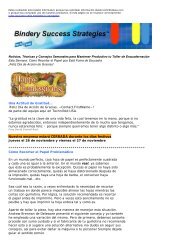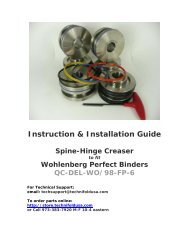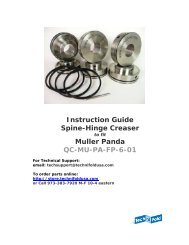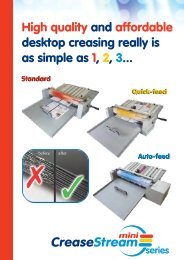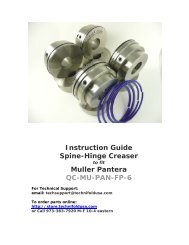How to Get the Most from Your Folding Machine ... - Technifold USA
How to Get the Most from Your Folding Machine ... - Technifold USA
How to Get the Most from Your Folding Machine ... - Technifold USA
Create successful ePaper yourself
Turn your PDF publications into a flip-book with our unique Google optimized e-Paper software.
Step 2 – Less is More: Why Higher Bindery Equipment<br />
Speed Does NOT Always Equal More Productivity<br />
You might think that a discussion about folding machine productivity<br />
could never be heated. Think again! In my early years with a commercial<br />
printing company, <strong>the</strong> subject of folder speed versus productivity was divisive,<br />
causing lengthy discussion and loud disagreement among folder opera<strong>to</strong>rs<br />
and shop management.<br />
Since man began putting ink on paper, one of <strong>the</strong><br />
driving-force questions has always been “<strong>How</strong> can<br />
we do this faster?” Answers <strong>to</strong> that question have<br />
led <strong>to</strong> remarkable new technologies in printing and bindery equipment and<br />
<strong>the</strong>re is always something faster and better on <strong>the</strong> horizon.<br />
The big disagreement would arise however, over how <strong>to</strong> get <strong>the</strong> maximum<br />
productivity <strong>from</strong> <strong>the</strong> varied bindery equipment at hand. The "experienced"<br />
opera<strong>to</strong>rs steadfastly insisted, <strong>to</strong> <strong>the</strong> point of becoming red-faced, that you<br />
simply had <strong>to</strong> crank up <strong>the</strong> speed control and run <strong>the</strong> machine as fast as it<br />
would possibly run. It didn’t matter if you had <strong>to</strong> s<strong>to</strong>p frequently for reloading<br />
or for clearing paper jams.<br />
I argued that if you ran <strong>the</strong> machine at <strong>the</strong> maximum non-s<strong>to</strong>p speed<br />
possible, <strong>the</strong> yield at <strong>the</strong> end of <strong>the</strong> shift would be greater than <strong>the</strong>ir crank-itup-<strong>to</strong>-10<br />
effort. If for example, you were <strong>to</strong> run <strong>the</strong> folder at 4000 sheets an<br />
hour without having <strong>to</strong> s<strong>to</strong>p <strong>to</strong> reload, <strong>to</strong> catch up on <strong>the</strong> delivery, <strong>to</strong> make<br />
adjustments, <strong>the</strong>n you would get more done than <strong>the</strong> guy who turned <strong>the</strong><br />
machine up <strong>to</strong> 6000 sheets an hour but had <strong>to</strong> s<strong>to</strong>p every few minutes <strong>to</strong> take<br />
care of something. They were confusing machine speed with productivity.<br />
Kevin Carey of DieInfo.com writes about machine productivity in his ABC’s<br />
of Diemaking & Diecutting, “almost anyone can run a press [or folding<br />
machine in our case] at its slowest speed, but far fewer can run <strong>the</strong><br />
© <strong>Technifold</strong> <strong>USA</strong> 2012 All Rights Reserved 5




